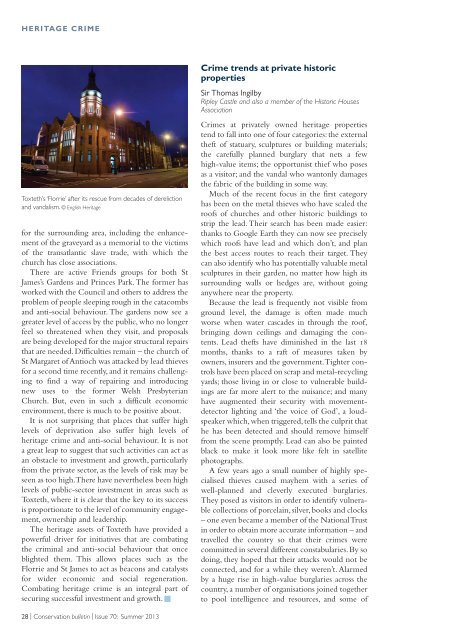Conservation Bulletin 70 | PDF - English Heritage
Conservation Bulletin 70 | PDF - English Heritage
Conservation Bulletin 70 | PDF - English Heritage
Create successful ePaper yourself
Turn your PDF publications into a flip-book with our unique Google optimized e-Paper software.
HERITAGE CRIME<br />
Toxteth’s ‘Florrie’ after its rescue from decades of dereliction<br />
and vandalism. © <strong>English</strong> <strong>Heritage</strong><br />
for the surrounding area, including the enhancement<br />
of the graveyard as a memorial to the victims<br />
of the transatlantic slave trade, with which the<br />
church has close associations.<br />
There are active Friends groups for both St<br />
James’s Gardens and Princes Park.The former has<br />
worked with the Council and others to address the<br />
problem of people sleeping rough in the catacombs<br />
and anti-social behaviour. The gardens now see a<br />
greater level of access by the public, who no longer<br />
feel so threatened when they visit, and proposals<br />
are being developed for the major structural repairs<br />
that are needed. Difficulties remain – the church of<br />
St Margaret of Antioch was attacked by lead thieves<br />
for a second time recently, and it remains challenging<br />
to find a way of repairing and introducing<br />
new uses to the former Welsh Presbyterian<br />
Church. But, even in such a difficult economic<br />
environment, there is much to be positive about.<br />
It is not surprising that places that suffer high<br />
levels of deprivation also suffer high levels of<br />
heritage crime and anti-social behaviour. It is not<br />
a great leap to suggest that such activities can act as<br />
an obstacle to investment and growth, particularly<br />
from the private sector, as the levels of risk may be<br />
seen as too high.There have nevertheless been high<br />
levels of public-sector investment in areas such as<br />
Toxteth, where it is clear that the key to its success<br />
is proportionate to the level of community engagement,<br />
ownership and leadership.<br />
The heritage assets of Toxteth have provided a<br />
powerful driver for initiatives that are combating<br />
the criminal and anti-social behaviour that once<br />
blighted them. This allows places such as the<br />
Florrie and St James to act as beacons and catalysts<br />
for wider economic and social regeneration.<br />
Combating heritage crime is an integral part of<br />
securing successful investment and growth. ■<br />
Crime trends at private historic<br />
properties<br />
Sir Thomas Ingilby<br />
Ripley Castle and also a member of the Historic Houses<br />
Association<br />
Crimes at privately owned heritage properties<br />
tend to fall into one of four categories: the external<br />
theft of statuary, sculptures or building materials;<br />
the carefully planned burglary that nets a few<br />
high-value items; the opportunist thief who poses<br />
as a visitor; and the vandal who wantonly damages<br />
the fabric of the building in some way.<br />
Much of the recent focus in the first category<br />
has been on the metal thieves who have scaled the<br />
roofs of churches and other historic buildings to<br />
strip the lead. Their search has been made easier:<br />
thanks to Google Earth they can now see precisely<br />
which roofs have lead and which don’t, and plan<br />
the best access routes to reach their target. They<br />
can also identify who has potentially valuable metal<br />
sculptures in their garden, no matter how high its<br />
surrounding walls or hedges are, without going<br />
anywhere near the property.<br />
Because the lead is frequently not visible from<br />
ground level, the damage is often made much<br />
worse when water cascades in through the roof,<br />
bringing down ceilings and damaging the contents.<br />
Lead thefts have diminished in the last 18<br />
months, thanks to a raft of measures taken by<br />
owners, insurers and the government.Tighter controls<br />
have been placed on scrap and metal-recycling<br />
yards; those living in or close to vulnerable buildings<br />
are far more alert to the nuisance; and many<br />
have augmented their security with movementdetector<br />
lighting and ‘the voice of God’, a loudspeaker<br />
which, when triggered, tells the culprit that<br />
he has been detected and should remove himself<br />
from the scene promptly. Lead can also be painted<br />
black to make it look more like felt in satellite<br />
photographs.<br />
A few years ago a small number of highly specialised<br />
thieves caused mayhem with a series of<br />
well-planned and cleverly executed burglaries.<br />
They posed as visitors in order to identify vulnerable<br />
collections of porcelain, silver, books and clocks<br />
– one even became a member of the National Trust<br />
in order to obtain more accurate information – and<br />
travelled the country so that their crimes were<br />
committed in several different constabularies. By so<br />
doing, they hoped that their attacks would not be<br />
connected, and for a while they weren’t. Alarmed<br />
by a huge rise in high-value burglaries across the<br />
country, a number of organisations joined together<br />
to pool intelligence and resources, and some of<br />
28 | <strong>Conservation</strong> bulletin | Issue <strong>70</strong>: Summer 2013

















